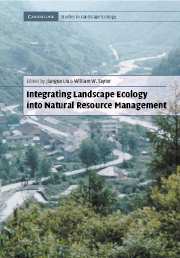Book contents
- Frontmatter
- Contents
- List of contributors
- Foreword
- Preface
- Acknowledgments
- PART I Introduction and concepts
- PART II Landscape structure and multi-scale management
- PART III Landscape function and cross-boundary management
- PART IV Landscape change and adaptive management
- PART V Landscape integrity and integrated management
- 14 Putting multiple use and sustained yield into a landscape context
- 15 Integrating landscape ecology into fisheries management: A rationale and practical considerations
- 16 Applications of advanced technologies in studying and managing grassland landscape integrity
- 17 An integrated approach to landscape science and management
- PART VI Syntheses and perspectives
- Index
- Plate Section
15 - Integrating landscape ecology into fisheries management: A rationale and practical considerations
Published online by Cambridge University Press: 14 January 2010
- Frontmatter
- Contents
- List of contributors
- Foreword
- Preface
- Acknowledgments
- PART I Introduction and concepts
- PART II Landscape structure and multi-scale management
- PART III Landscape function and cross-boundary management
- PART IV Landscape change and adaptive management
- PART V Landscape integrity and integrated management
- 14 Putting multiple use and sustained yield into a landscape context
- 15 Integrating landscape ecology into fisheries management: A rationale and practical considerations
- 16 Applications of advanced technologies in studying and managing grassland landscape integrity
- 17 An integrated approach to landscape science and management
- PART VI Syntheses and perspectives
- Index
- Plate Section
Summary
Introduction
Fisheries exist throughout the world wherever people and water meet (Nielsen, 1999). Essentially, a fishery can be defined as a complex system made up of three interacting components: habitat, the aquatic environment where an organism lives; biota, the living organisms in the aquatic ecosystem; and people, who harvest the biotic resource or who change the condition of its environment (Willis and Murphy, 1996). Throughout its history, the principal goal of fisheries management has been “to provide people with a sustained, high, and ever increasing benefit from their use of living aquatic resources” by manipulating these three components (Nielsen, 1999). Over time, the primary focus of fisheries management has shifted from providing the maximum sustainable harvest to providing a variety of different benefits that arise as a result of the interaction of people, habitats, and organisms (see Nielsen, 1999 for a brief history of fisheries management).
In the beginning, fisheries management was primarily concerned with providing food, and secondarily with providing economic benefit, for an everincreasing human population. For this reason, fish were viewed as crops, and the efficient use of fish populations, or providing maximum sustainable yield (MSY), became the driving philosophy during the early twentieth century (Nielsen, 1999). To provide MSY, fishery managers focused on a single-species, single-habitat approach, using population dynamics and biological yield models to predict the maximum harvest level a fishery could sustain. However, as the human population grew, demands on fishery resources and aquatic habitats increased, and fishery scientists began to realize that maximizing the weight or number of fish harvested was not always the most appropriate goal for a fishery.
Information
- Type
- Chapter
- Information
- Integrating Landscape Ecology into Natural Resource Management , pp. 366 - 389Publisher: Cambridge University PressPrint publication year: 2002
Accessibility standard: Unknown
Why this information is here
This section outlines the accessibility features of this content - including support for screen readers, full keyboard navigation and high-contrast display options. This may not be relevant for you.Accessibility Information
- 3
- Cited by
